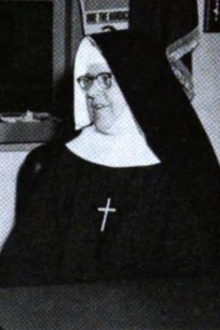Elizabeth Simpson Burke (August 22, 1906 – December 16, 2005),[1] usually known as Sister Joan Margaret, was a member of the Anglican Society of Saint Margaret and a missionary in Haiti. She founded Saint Vincent Centre for Disabled Children in Port-au-Prince in the 1940s, and was the school's principal for decades.
Early life and education
editElizabeth Burke was born in Merrimac, Massachusetts, the daughter of David W. Gardner and Adeline B. Hemmenway.[2] She was raised Newburyport, Massachusetts by her adoptive parents, Robert Burke and Mabel Wood Simpson Burke. Robert Burke was an attorney, and mayor of Newburyport when Elizabeth was young.[3] She trained as a physical therapist. She joined the Anglican religious order, the Society of Saint Margaret, in 1937.[4][5][6]
Career
editSister Joan Margaret did parish work in Utica, New York and at a mission in Bracebridge, Ontario. She arrived in Haiti in 1944 as a parish visitor, and opened a day nursery. Her work developed into the St. Vincent's School for Handicapped Children in the capital city, opened in 1945[7] and licensed in 1950.[5] The school included dormitories, medical and dental clinics, and an orthopedics shop.[8] She especially encouraged musical training, and led the school's orchestra and handbell choir on international tours. One of her students was violinist Romel Joseph.[4]
Sister Joan Margaret accompanied students to the United States for medical treatment when needed.[9] She toured in the United States, especially in Florida, speaking about her work at Episcopal Church events, to raise funds and awareness.[10] "It's a life to live, not a work to be done," she explained of her vocation.[11] In 1980, she and Harold Russell were honored by the Kessler Institute for Rehabilitation, for their work on behalf of disabled people.[9]
Personal life and legacy
editSister Joan Margaret had arthritis that required the use of crutches by the late 1970s,[12] and she used a wheelchair by the mid-1980s.[8] She retired from Haiti in 2003; she died in Brookline, Massachusetts in 2005, at the age of 99.[4] Her school, now known as St. Vincent's Center for Children with Disabilities in Haiti, remains in operation,[1] but at a new, more accessible site[13] after the former buildings were destroyed, and several students died, in the 2010 Haiti earthquake.[3][14]
References
edit- ^ a b "St. Vincent's Center For Children With Disabilities in Haiti". St. Vincent’s Center For Children With Disabilities in Haiti: Leadership. Retrieved 2023-05-01.
- ^ U.S. Social Security Applications and Claims Index, via Ancestry.
- ^ a b "Haiti quake brought death to school founded by a local nun". The Daily News of Newburyport. March 11, 2010. Retrieved 2023-05-01.
- ^ a b c Negri, Gloria (January 4, 2006). "Sister Joan Margaret, a savior to Haiti's disabled". The Boston Globe. Retrieved 2023-05-01.
- ^ a b "The Soap Box tree". Performance: The Story of the Handicapped. 8 (6): 8–10. December 1957.
- ^ "History of the Society of St. Margaret". Society of St. Margaret. Retrieved 2023-05-01.
- ^ "Healing in Haiti (press release)". Diocesan Press Service. September 1, 1962. Retrieved 2023-05-01.
- ^ a b McNiff, Susie. "Change Of Course In Haiti". The Episcopal New Yorker. Retrieved 2023-05-01.
- ^ a b "Kessler Institute Will Honor 2". The Herald-News. 1980-05-30. p. 8. Retrieved 2023-05-01 – via Newspapers.com.
- ^ "Episcopal Group Hears of Work With Handicapped". The Evening Tribune. 1956-11-02. p. 5. Retrieved 2023-05-01 – via Newspapers.com.
- ^ "Noted Nun Credits Works to Corporate Prayer Life". The Miami Herald. 1956-10-27. p. 22. Retrieved 2023-05-01 – via Newspapers.com.
- ^ Naunton, Ena (1974-11-22). "She Makes Sun Rise for Kids". The Miami Herald. p. 192. Retrieved 2023-05-01 – via Newspapers.com.
- ^ "New Site, New Life for St. Vincent's Center in Haiti". Episcopal Church Foundation (ECF). May 2, 2018. Retrieved 2023-05-01.
- ^ Campbell, Kay (2010-10-22). "All heart: Armless Haitian artists serve neighbors". al. Retrieved 2023-05-01.
External links
edit- A news photo of Sister Joan Margaret in the 1940s, by Margaret Craig, from the Ann Arbor News and the Ann Arbor District Library
